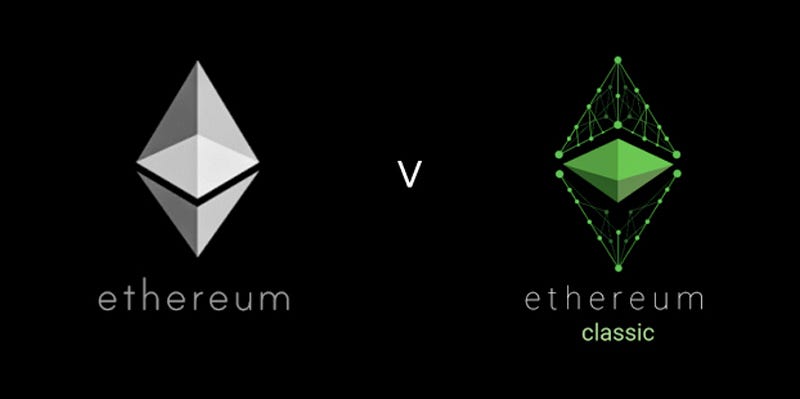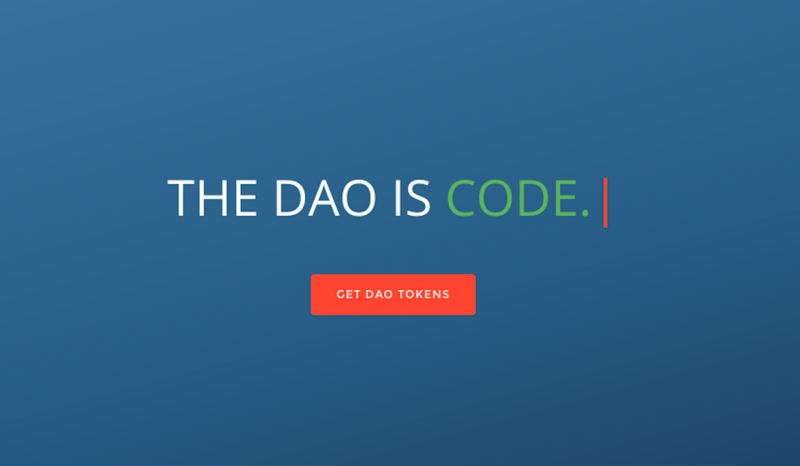Ethereum Classic: support censorship-resistant Ethereum
More than two years after the infamous DAO (Decentralized Autonomous Organization) hacking, which ultimately led to a split in the Ethereum network, resulting in Ethereum Classic and Ethereum chains, let's look at the debate, see what has changed and look for an answer popular hashtag offer on social networks - is it a classic?

What happened?
Background
Ethereum was first proposed by Vitalik Buterin in 2013, as he was unable to reach agreement on his argument that Bitcoin needed a scripting language for developing applications. Ethereum was later financed by massive sales in the middle of 2014, when 11.9 million “Pre-Minted” coins were sold, and “code is the law” as a key principle. On July 30, 2015, the genesis block was released on this new open platform of intelligent contracts for distributed computing with open source based on blockchains, and almost a year of relative harmony and growth of the community followed.
DAO
DAO was a decentralized autonomous open source organization that effectively worked as a decentralized venture capital fund for voting and investing in future dApps applications in the system. He sought to create a decentralized alternative business model based on the Ethereum blockchain, without a formal location, management structure or board of directors and not tied to the nation state. The DAO crowd financed the sale of tokens in May 2016 and set the largest crowd funding record at that time, collecting more than $ 150 million from more than 11,000 investors within 28 days. Indeed, at that time he drew more than 14% of the total amount of ether. Investors then owned DAO tokens, which gave voting rights on potential projects.

In June 2016, malicious players exploited a vulnerability in the DAO code (not Ethereum), which allowed them to extract about one-third of the DAO funds, and then the price of Ethereum dropped from $ 20 to $ 13. [1] The stolen DAO funds were in the Child DAO account (a split function designed to abandon the approved dApp application with the funds returned and to create your own DAO), but this is a 28-day retention period in accordance with the terms of the smart contract therefore, the funds have not really been dismissed yet, and this gave DAO members and the Ethereum community time to discuss what to do next.
Some have called it the right, albeit unethical step, and therefore nothing can be done / interfered. Some wanted the stolen air to be reassigned, while others wanted the DAO to be closed. Vitaly Buterin initially proposed a soft-plug solution to effectively freeze assets from expenses while a further solution is being developed.
However, this was challenged and opened up a potential vector of DoS attack (denial of service). After this bitter discussion, on July 20, 2016 at 13:20:40 + UTC, in block 1920000, the majority (more than 80%) of Ethereum community (the holders of the broadcast through informal carbon voting and nodes / miners by voting) decided to roll back transactions part of the lost funds before the original contract with the help of hard fork. Once this is done, you cannot return, you either followed the old rules in the original blockchain, or followed the new rules in the new one.
This was highly controversial, requiring at least 51% of the nodes to agree to rewrite history. The original unrelated chain continued to be called Ethereum Classic, and Ethereum turned into a separate blockchain with its own cryptocurrency, including rollback. DAO was removed from the list in the same year.

Arguments for Ethereum Classic
The main argument in favor of Ethereum Classic (and, therefore, against the hard fork) comes down to the fundamental importance of platform immutability (the principle that the blockchain cannot and should not be changed) and the concept that “code is law” was previously supported by the founders and DAO, ensuring that no organization or collusion can / cannot control it. It is assumed that smart contracts are their own arbiter, where only the code can change the rules of transactions. Many believed that changing the whole chain as a result of one hacking caused damage to Ethereum’s goals and proved that human whims can affect the blockchain, even if the hacking personally damages irresponsible investors. Similar Barry Silbert and Charles Hoskinson supported this position.

The hard voting process for holders was based on the amount of Ether owned by them, and therefore the major players and the Ethereum Foundation (a non-profit organization created to promote and support the Ethereum platform) had a significant share of the vote and were likely concerned about the potential legal consequences. It was not one member, but one vote, and it questioned the conclusion that this was a community decision, because it was mostly one of those who had the highest stakes and who, unsurprisingly, wanted to protect themselves.
Indeed, it is believed that 25% of the actual votes came from a single address. Less than 6% of the total number of owners of the ether took part in the voting, and for many it was a complicated process. Those who also invested in DAO (owners, nodes, miners, etc.) obviously also had a greater incentive to vote. Since this unofficial “Carbon Voting” ended up in favor of a hard fork, this was then used as a basis for choosing this option as the default for client nodes. However, historically, hard forks have to be signed, which means that no voting should be considered as a lack of voting.
Acting on the pressure of the DAO community to recover their stolen funds, Acne and Ethereum Foundation were directly involved in the DAO, which was simply one of many applications that simply used Ethereum as a platform for expansion. Taking direct part and offering a soft, and then a tough proposal, this implied that such projects and their participants could influence the basic platform in their own interests, which contradicts the principles of a decentralized block chain and is more comparable to the role of a traditional bank. It was assumed that the hard forks are designed for emergency modifications of the Ethereum platform itself, and not to solve the problems of other projects that worked on it.
Ironically, in contrast to her position against financial corruption, she drew parallels with legacy financial markets and the concept of “too big to fail”. Since DAO at that time accounted for 14% of the total Ether, the community put off ideology and went to a centralized body (albeit with a consensus) to organize what actually was salvation. The Ethereum network should not have been a judge, jury and regulator for parties using projects built on it.
This also created a dangerous precedent. From this point on, how can anyone be sure that they will not intervene again and again in this manner based on human whims and requests from centralized bodies to solve problems, in contrast to how the system was developed. This may have been a one-off, but it definitely undermined the credibility of the Ethereum project.

Arguments against Ethereum Classic
While immutability is the basis of blockchain technology, as is consensus. In this case, about 80% of the community of Ethereum at that time voted for the effective restoration of the Ether, taken as a result of the exploit, to its affected owners. The consensus agreed with the ethnic argument over ideological in this case. It was a sensible decision for the majority of the community, seeking to return stolen tokens to their rightful owners, using an approach that was supported by Vitalik Buterin, Gavid Wood and other powerful people in the ecosystem.
Most of the developers, hash power and Enterprise Ethereum Alliance (EEA) also supported hard fork, while others instead consider supporting EEA (a powerful group of more than 200 corporations) as an argument in favor of Ethereum Classic. Despite the small number of participants and the significant ability to vote for larger players in the ecosystem, there was no mass exodus after a hard fork, and, in general, the majority of the community focused on the Ethereum chain.
Some also argue that the community against Ethereum openly supported Ethereum Classic to exacerbate the split and contribute to destruction.
If the hard fork did not take place, many would lose money, and some argue that a huge number of dApps, subsequently built on the platform, today may not exist. This is confirmed by indicators of market capitalization, suggesting that as a result Ethereum achieved greater success.

What has changed since then?
In January 2017, Ethereum Classic postponed a complexity bomb designed to move the original network from PoW to PoS, and also added replay protection to prevent transactions from being accepted on the Ethereum network in the Ethereum Classic chain. In December of the same year, changes in the monetary policy were aimed at further moving the protocol away from Ethereum by changing the unlimited aspect of issuing tokens to a fixed supply, comparable to bitcoins, but at a level of about 210 m.
Despite the expectations that the original chain would cease to exist, it seemed to have survived and flourished as Ethereum Classic, and its Coinbase lists the latest increase in the high-level support series for the platform in the industry.
Starting with hard fork, Ethereum continued to promote the rapid development of dApps and ICO during 2017 and then as the main use case, while Ethereum Classic retained the dApp smart capabilities for contracts, as well as the focus on the Internet of Things market and compatibility.
Ethereum Classic introduces PoW into the future just as Ethereum begins to move away from it, first as a hybrid system, and then as a full PoS network. There are various debates about the PoW v PoS strategy, especially when it comes to scaling, however, at least in the short term, you could assume that a potential forced transition for ETH miners to ETC would be useful for Ethereum Classic. Ultimately, only time will tell whether PoS or PoW with additional levels of solution will retain the best balance between scalability, security, and decentralization.
Conclusion
DAO was supposed to be revolutionary. How successful he may or may not be, we will never know. His influence was still enormous, although not in the way its developers would like. We must recognize, no matter which side of the discussion you are going through, an incredible return from what was a complete disaster. But this simply should not have happened, in my opinion. Platforms must be thoroughly tested, and similar vulnerabilities in DAO must be fixed long before they are launched. I cannot help but feel that the small team behind this bold vision of the DAO was completely taken aback by its success and was not sufficiently prepared or provided with resources for its effective implementation. Similarly, if you invest in something that has not been tried and tested, you are at significant risk.
I understand the importance of consensus, however, given the above arguments, the extent to which this was the true consensus of the entire community, measured in a fair and reasonable way, is questionable. The fact that the original majority followed Ethereum does not mean that they agreed or did not agree with what happened, simply because it’s easier to go with the crowd, or that they just wanted their own money back. Thus, it surpassed the importance of the blockchain principle, which had previously become the cornerstone of these platforms.
In addition, the argument that the anti-Ethereum community has openly supported the Ethereum Classic to encourage violation may or may not be true. However, it is unnecessary for the argument of the ideology of ethical poems. It is difficult to fairly evaluate the idea that the dApp number on the basis of Ethereum would no longer exist if the hard fork were not a measure of the success of the Ethereum chain. It also assumes that quantity has more value than potential quality, which I would strongly disagree with and assume that this was also one of the factors that caused the bear market that we saw in 2018. Ethereum platform too.
Therefore, for me, although I fully sympathize with people who would lose money, the victim of the fundamental principle of the decentralized immutability of the blockchain to cause salvation in this case is too far. For example, if the jury sympathizes and finds the defendant guilty innocent, does this consensus ensure fairness or injustice? For me, this is a system crash. Yes, a consensus can be argued, but this does not mean that the decision was ultimately the right one.
Following the steps taken since then, the apparent increased respect and support of ETC in the wider cryptographic community, comparable risks (regulatory or otherwise) and the roadmap strategy for the future, Ethereum Classic enjoys great confidence from my point of view, and therefore the sentence “Classic is coming” rings true when it is best to do it. Whether this correlates with long-term success is not yet known.

Disclaimer: The author is a user of Ethereum and Ethereum Classic among other cryptocurrencies. Investing or trading in cryptocurrencies carries significant risk. It is important to investigate and carefully evaluate any such investments. All information presented in this article does not constitute financial advice or recommendation of any kind.
AUTHOR:Gambangcity
ETH:0xbd4e6B6E19c55D117badfa5C218Ae03263df6072


Ethereum classic is one such cryptocurrency which is creating lot popularity among every common people and investors. Ethereum classic has dominated crypto market and it is performing very well.
BalasHapusCheck out:
ethereum classic price
ethereum classic price prediction
etc price